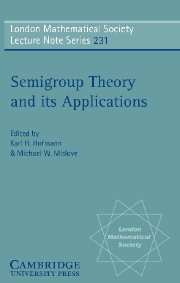 Semigroup Theory and its Applications
Semigroup Theory and its Applications Published online by Cambridge University Press: 05 April 2013
This article takes the form of a survey of results concerning a particular kind of involution — called, for want of a better term, ‘special’ — on a semigroup or ring. Most of the material is based on recent joint work by David Easdown (Sydney) and the author ([4], [5]); the remainder, comprising Section 3, is taken from [7].
Introduction
By an involution on a semigroup S we mean a mapping * : S → S, x ↦ x*, such that
Note that the second requirement ensures that * is a permutation of S further, if S is commutative then the identity permutation of S is an involution. An involution on a ring R is a mapping * : R → R that is an automorphism of the group (R, +) and an involution on the semigroup (R, ·).
We shall be concerned here with the following type of involution.
Definition. An involution * on a semigroup [ring] S is special if and only if, for every nonempty finite subset T of S,
Although our condition might, at first sight, appear somewhat complicated — and even artificial — it is satisfied frequently and in a variety of natural contexts. First, let us consider some examples.
Example 1. On a group G, inversion (x ↦ x−1) is a special involution.
This is a trivial matter. Let T be a nonempty subset (not necessarily finite) of G, let t be an arbitrary member of T and let u, v ∈ G be such that tt−1 = uv−1. Then u = v.
Example 2. Let S denote the free semigroup on a nonempty set X.
To save this book to your Kindle, first ensure [email protected] is added to your Approved Personal Document E-mail List under your Personal Document Settings on the Manage Your Content and Devices page of your Amazon account. Then enter the ‘name’ part of your Kindle email address below. Find out more about saving to your Kindle.
Note you can select to save to either the @free.kindle.com or @kindle.com variations. ‘@free.kindle.com’ emails are free but can only be saved to your device when it is connected to wi-fi. ‘@kindle.com’ emails can be delivered even when you are not connected to wi-fi, but note that service fees apply.
Find out more about the Kindle Personal Document Service.
To save content items to your account, please confirm that you agree to abide by our usage policies. If this is the first time you use this feature, you will be asked to authorise Cambridge Core to connect with your account. Find out more about saving content to Dropbox.
To save content items to your account, please confirm that you agree to abide by our usage policies. If this is the first time you use this feature, you will be asked to authorise Cambridge Core to connect with your account. Find out more about saving content to Google Drive.